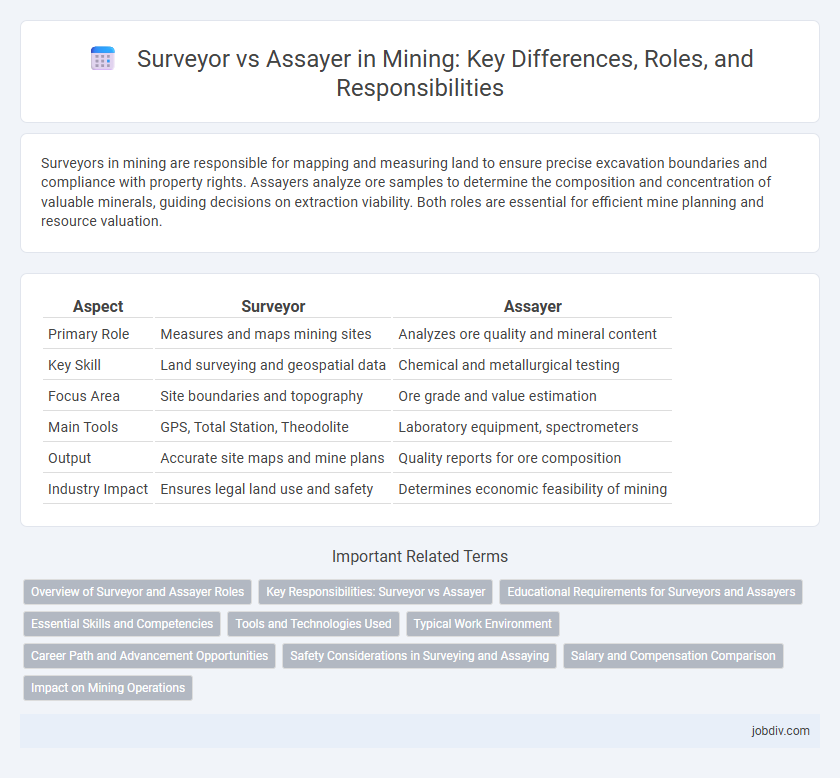Surveyors in mining are responsible for mapping and measuring land to ensure precise excavation boundaries and compliance with property rights. Assayers analyze ore samples to determine the composition and concentration of valuable minerals, guiding decisions on extraction viability. Both roles are essential for efficient mine planning and resource valuation.
Table of Comparison
| Aspect | Surveyor | Assayer |
|---|---|---|
| Primary Role | Measures and maps mining sites | Analyzes ore quality and mineral content |
| Key Skill | Land surveying and geospatial data | Chemical and metallurgical testing |
| Focus Area | Site boundaries and topography | Ore grade and value estimation |
| Main Tools | GPS, Total Station, Theodolite | Laboratory equipment, spectrometers |
| Output | Accurate site maps and mine plans | Quality reports for ore composition |
| Industry Impact | Ensures legal land use and safety | Determines economic feasibility of mining |
Overview of Surveyor and Assayer Roles
Surveyors in mining are responsible for measuring and mapping land areas to ensure accurate site boundaries and compliance with regulations. Assayers analyze the composition of ore samples to determine metal content and assess the economic viability of mining projects. Both roles are critical for efficient resource management and operational planning in mining exploration and development.
Key Responsibilities: Surveyor vs Assayer
Surveyors in mining are responsible for measuring and mapping mine sites to ensure accurate land boundaries and safe excavation, using tools like GPS and total stations. Assayers analyze ore samples to determine the composition and value of minerals, employing techniques such as spectroscopy and chemical assays. Both roles are crucial for efficient resource management and operational safety, with surveyors focusing on spatial data and assayers on material quality.
Educational Requirements for Surveyors and Assayers
Surveyors in mining typically require a bachelor's degree in surveying, geomatics, or civil engineering, combined with practical field experience and professional licensure. Assayers generally need a degree in chemistry, metallurgy, or geology, along with specialized training in mineral analysis techniques and certification from recognized professional bodies. Both professions demand strong expertise in their respective technical fields to ensure accurate measurement, analysis, and reporting of mineral resources.
Essential Skills and Competencies
Surveyors in mining require expertise in geospatial measurements, land mapping, and data interpretation to accurately delineate mining boundaries and ensure regulatory compliance. Assayers must possess strong analytical skills, proficiency in chemical analysis, and attention to detail to accurately evaluate ore samples and determine mineral content. Both roles demand precision and technical knowledge, but surveyors focus on spatial accuracy while assayers prioritize metallurgical characterization.
Tools and Technologies Used
Surveyors in mining utilize GPS, total stations, and drone mapping technology to measure and map land resources with high precision. Assayers employ spectrometers, atomic absorption instruments, and X-ray fluorescence analyzers to chemically analyze ore samples and determine mineral content. Both professions rely on advanced software for data processing, but surveyors emphasize spatial measurement tools while assayers focus on laboratory analytical equipment.
Typical Work Environment
Surveyors typically work outdoors at mining sites, navigating varied terrains to map and measure land boundaries and mineral claims with GPS and total stations. Assayers usually operate in laboratories or processing facilities, analyzing ore samples using chemical, spectroscopic, or metallurgical techniques to determine mineral content. Both roles require adherence to safety protocols, but surveyors face more exposure to environmental elements while assayers handle hazardous materials in controlled settings.
Career Path and Advancement Opportunities
Surveyors in mining specialize in land measurement, mapping, and site layout, offering career advancement through roles like senior surveyor or project manager, often requiring expertise in GPS and CAD technology. Assayers focus on analyzing ore samples to determine metal content and quality, with advancement opportunities leading to chief assayer or laboratory manager positions, emphasizing skills in chemistry and metallurgy. Both careers demand strong analytical abilities and field experience, but surveyors lean toward spatial data management, while assayers concentrate on laboratory analysis and mineral valuation.
Safety Considerations in Surveying and Assaying
Surveyors and assayers play critical roles in mining, with safety as a paramount concern during both surveying and assaying processes. Surveyors must adhere to strict protocols to prevent accidents in challenging terrains, including using personal protective equipment (PPE) and ensuring accurate geospatial data collection to avoid hazardous zones. Assayers handle potentially toxic materials, requiring controlled laboratory environments, proper ventilation, and rigorous chemical handling procedures to minimize exposure to harmful substances.
Salary and Compensation Comparison
Surveyors in the mining industry typically earn an average annual salary ranging from $60,000 to $95,000, reflecting their crucial role in measuring and mapping mining sites. Assayers generally receive higher compensation, with salaries often between $70,000 and $110,000, due to their specialized expertise in analyzing ore quality and mineral content. Variations in salary depend on experience, location, and the complexity of mining projects involved.
Impact on Mining Operations
Surveyors play a crucial role in mining operations by accurately mapping and defining mine boundaries, ensuring optimal extraction and compliance with legal regulations. Assayers provide essential analysis of mineral content and ore quality, directly influencing decisions on processing methods and economic viability. The collaboration between surveyors and assayers enhances resource estimation accuracy, operational efficiency, and profitability in mining projects.
Surveyor vs Assayer Infographic

 jobdiv.com
jobdiv.com